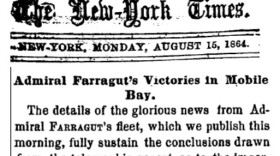This week marks one hundred and fifty years since the Battle of Mobile Bay. For the past week, the Alabama Public Radio newsroom has been looking back on the battle and at Alabama’s role in the war in 1864. Union forces wanted Mobile Bay because it was a sea port. They wanted the city of Decatur for a similar reason. It may not seem like it today, but 150 years ago Decatur, Alabama was a significant crossroads for commerce in the south. In the days before the Tennessee Valley Authority tamed the Tennessee River, Muscle Shoals was an impassable series of rapids. That left Decatur in an ideal place for large vessels looking to travel down the river.
“It’s significant in that way and also for the railroad traffic. We have the East-West and we also have the North-South railroad here the Nashville and Decatur Railroad,” says Morgan County Archivist John Allison. “And it made Decatur important strategically beyond the size of the community. It was a fairly small community at that time, but both sides at one point or another found Decatur significant enough to protecting it.”
The town had been taken and retaken by both sides until the spring of 1864. That’s when Union commanders decided to essentially destroy the town.
“And it was destroyed in a most unusual way,” says David Breland, Director of Historic Resources for the City of Decatur. “Very few things were burned here most of the buildings were torn down and the building materials were taken to build various buildings used by the Union army and also as a portion of the fortifications the Union Army set up here.”
Only a few buildings were spared. The list of survivors includes the Old State Bank which still stands. So by the time late October rolled around, Decatur was pretty much a fortified stronghold of the North. It was the only Union fortification south of the Tennessee River. Confederate General John Hood was now in a race to cut off Union General George Thomas and prevent Union forces from reassembling around Nashville. But first Allison says Hood needed to get into Tennessee.
“Hood’s in a difficult position, he wants to move to Nashville as quickly as he can. But he has certain constraints, the length of his wagon train, where can he cross, and he’s beginning to be a little more conservative about how he’s playing his cards here.”
Hood first tried to cross in Guntersville. But, he was worried about federal gunboats destroying any pontoon bridge he might build. Historian Jonathan Baggs says Hood marches 20,000 plus troops west to Decatur.
“Hood by this time sees that Decatur has entrenched fortifications and he’s not that keen to take it,” says Baggs. “But there is the pontoon bridge and if he’d gotten the pontoon bridge he gets Nashville if he gets Nashville and beats Thomas there he can open up the Ohio Valley.”
Skirmishes would break out on the first day claiming the life of Confederate Lieutenant William Sykes. In this excerpt from letter a letter by Sykes’s brother, he tells his family how William died.
“I have seen the brave, the cowardly, the good, the wicked, die: but never have I seen one who went so composedly, so rationally to the grave. Not a tear bedewed his cheek, not a murmur escaped his lips. He received the fatal wound at three o’clock in the afternoon October 26, 1864, and at ten o’ clock the next morning, his spotless, untarnished spirit winged its tireless flight to that other world, where morning reveilles and evening tattoos are sounded on angel’s harps.”
It was a tough evening and day for the Confederate troops as more skirmishing broke out. But by the evening they were able to push forward to a ravine about 500 yards from the federal line. Here’s an account of the battle from the Daily Richmond Examiner.
“Our boys had another cold night, but now they were close to the Yankees. But this would not hold when the morning came. On the morning of the 28th despite another dense fog developed in the entrenchments federal skirmishers moved forward under cover of the fort and drove our skirmishers back.”
This last action forced General Hood to withdraw his army. He decided he couldn’t afford the casualties from a full-scale assault. General John Schofield’s men were able to make it to Franklin, Tennessee and settle in much to the chagrin of Confederate General Hood.
“Hood was so enraged, he was literally pulling his hair out and screaming at his generals,” says Baggs. “And he said we are going to attack and he threw them into battle in the late afternoon November 30th at Franklin and just decimated his own army. Simply because he was mad, there was no reason for that battle to happened.”
Battles of greater recognition were fought at the time but maybe none more significant than the Battle of Decatur.
“What happened at Decatur and then the subsequent battle in Tennessee that are all linked together, in my opinion, that ended the south as an effective fighting force virtually everywhere except in the Virginia area with Lee’s Army,” says Breland.
Four days in October nearly 150 years ago could have turned the tide for the Confederacy, if not for the men who protected the Tennessee River in North Alabama.

















